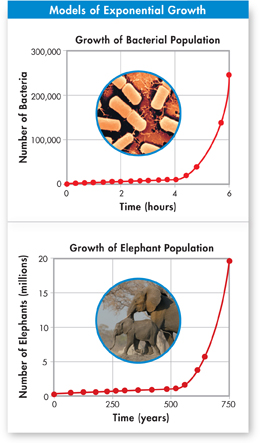Organisms That Reproduce Rapidly We begin a hypothetical experiment with a single bacterium that divides to produce two cells every 20 minutes. We supply it with ideal conditions—and watch. After 20 minutes, the bacterium divides to produce two bacteria. After another 20 minutes, those two bacteria divide to produce four cells. At the end of the first hour, those four bacteria divide to produce eight cells.
Do you see what is happening here? After three 20-minute periods, we have 2 × 2 × 2, or 8 cells. Another way to say this is to use an exponent: 23 cells. In another hour (six 20-minute periods), there will be 26, or 64 bacteria. In just one more hour, there will be 29, or 512. In one day, this bacterial population will grow to an astounding 4,720,000,000,000,000,000,000 individuals. What would happen if this growth continued without slowing down? In a few days, this bacterial population would cover the planet!
If you plot the size of this population on a graph over time, you get a J-shaped curve that rises slowly at first, and then rises faster and faster, as shown in Figure 5–4. If nothing interfered with this kind of growth, the population would become larger and larger, faster and faster, until it approached an infinitely large size.
BUILD Vocabulary
RELATED WORD FORMS An exponent indicates the number of times a number is multiplied by itself. The adjective exponential describes something that is expressed using exponents—such as the rate of growth.

FIGURE 5–4 Exponential Growth In the presence of unlimited resources and in the absence of predation and disease, populations will grow exponentially. Bacteria, which reproduce rapidly, can produce huge populations in a matter of days. It would take elephants, which reproduce slowly, a few hundred years. Both hypothetical graphs show the characteristic J-shape of exponential growth.
dOrganisms That Reproduce Slowly Of course, many organisms grow and reproduce much more slowly than bacteria. For example, a female elephant can produce a single offspring only every 2 to 4 years. Newborn elephants take about 10 years to mature. But as you can see in Figure 5–4, if exponential growth continued, the result would be impossible. In the unlikely event that all descendants of a single elephant pair survived and reproduced, after 750 years there would be nearly 20 million elephants!
Organisms in New Environments Sometimes, when an organism is moved to a new environment, its population grows exponentially for a time. That's happening with hydrilla in the United States. It also happened when a few European gypsy moths were accidentally released from a laboratory near Boston. Within a few years, these plant-eating pests had spread across the northeastern United States. In peak years, they devoured the leaves of thousands of acres of forest. In some places, they formed a living blanket that covered the ground, sidewalks, and cars.
 In Your Notebook Draw a growth curve for a population of waterweed growing exponentially.
In Your Notebook Draw a growth curve for a population of waterweed growing exponentially.

Table of Contents
- Formulas and Equations
- Applying Formulas and Equations
- Mean, Median, and Mode
- Estimation
- Using Measurements in Calculations
- Effects of Measurement Errors
- Accuracy
- Precision
- Comparing Accuracy and Precision
- Significant Figures
- Calculating With Significant Figures
- Scientific Notation
- Calculating With Scientific Notation
- Dimensional Analysis
- Applying Dimensional Analysis




